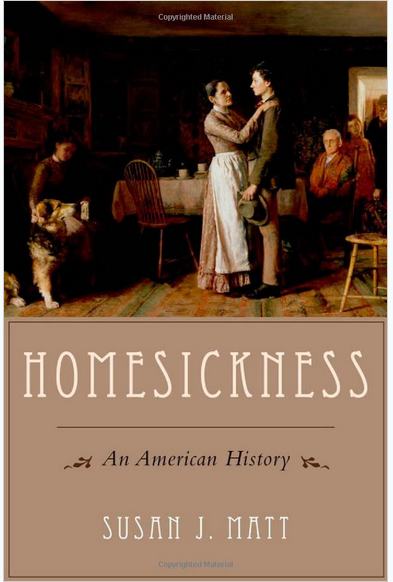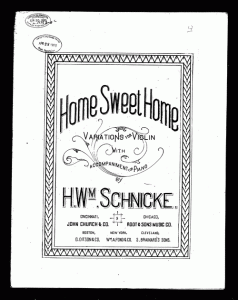 Susan J. Matt is Presidential Distinguished Professor of History at Weber State University, and a leading historian of emotions in the United States. Her first book, Keeping Up With the Joneses, was a study of envy in modern consumer society. Her latest work tackles another emotion: homesickness. Susan very kindly agreed to conduct an interview with the History of Emotions blog about her new book – Homesickness: An American History (Oxford University Press, 2011), explaining how homesickness and nostalgia were transformed from deadly maladies to allegedly un-American emotions.
Susan J. Matt is Presidential Distinguished Professor of History at Weber State University, and a leading historian of emotions in the United States. Her first book, Keeping Up With the Joneses, was a study of envy in modern consumer society. Her latest work tackles another emotion: homesickness. Susan very kindly agreed to conduct an interview with the History of Emotions blog about her new book – Homesickness: An American History (Oxford University Press, 2011), explaining how homesickness and nostalgia were transformed from deadly maladies to allegedly un-American emotions.
Thomas Dixon [TD]: Hello, Susan, and thanks for talking to us. Perhaps I could start by asking you what got you interested in homesickness?
Susan Matt [SM]: The original impetus was that my own emotional experience of mobility didn’t match up with the mythology of American restlessness. Commentators like Tocqueville and Frederick Jackson Turner as well more modern observers all claimed Americans were naturally restless, that somehow it was in our cultural DNA to leave home. I didn’t find it so effortless or easy to move, and began to wonder if I was alone. Perhaps there was a flip side to American mobility–a hidden history of homesickness. Homesickness also interested me because it seemed in many ways to be the opposite of an emotion I had just been studying–envy. Envy sparks aspirations, pushes people forward, often causes mobility. Homesickness pulls backwards. Both emotions play a role in modern individualism in the U.S.. Americans are encouraged to repress homesickness so they can leave home, be independent, seek more of the world’s goods, act on their envy.
TD: It’s interesting that it was your own emotions that fuelled your desire to revisit their history. I suspect many historians of emotion are in that position. So, what surprised you most about what you discovered when you started digging around in the history of homesickness?
SM: First, how prevalent the emotion was. I thought it would be difficult to unearth, but instead, evidence of homesickness was abundant and easy to find in just about every archive I worked in. Secondly, and perhaps more provocatively, I was surprised at how many Americans died of homesickness, or nostalgia as it was called. I knew there had been European epidemics of nostalgia in the seventeenth, eighteenth, and nineteenth centuries, but didn’t know of American ones. But indeed, the disease of nostalgia was widely known in the United States–during the Civil War, there were 74 deaths from it on the Union side, and more than 5,200 cases of it in the Surgeon General’s records.

- American sheet music of ‘Home, Sweet Home’ arranged for piano and violin, c. 1870s. Source of image: American History Online
It became such a problem that army bands were sometimes prohibited from playing “Home, Sweet Home,” which at that time, was the most popular song in the country. In peacetime, civilians suffered from nostalgia as well. The prevalence and intensity of nostalgia and homesickness throughout U.S. history – from the colonial era to the present -ultimately led me to question whether we were and are the individualists that we are so widely reputed to be. I think we’re not.
TD: I’ve been struck too by the great power of the passions in earlier periods – to cause illness, madness or even death. Medical sources of the eighteenth and nineteenth centuries abound with fatal bouts of emotion. Is it possible to pinpoint a date after which this changed – when homesickness and nostalgia became mere feelings rather than powerful and potentially fatal mental conditions?
SM: It gradually disappeared as a dangerous disease in the first half of the 20th century. The U.S. Army provides a useful gauge in its records. One soldier in the American Expeditionary Force reportedly died of nostalgia during World War I. Increasingly during the War, however, many of the symptoms associated with nostalgia came to be defined as signs of the newly established syndrome of shell shock. While the diagnosis of nostalgia stayed on the books up through World War II, and while there were many reported cases of it among soldiers in that war, there were no deaths. In short, from the early twentieth century on, the number of cases of deadly nostalgia declined, although less lethal cases of homesickness continued (and continue) to abound. It seems worth noting that as nostalgia’s cultural meaning underwent this transformation, the tolerance for the acutely homesick declined, since their condition was now seen as less dire.
TD: Historically you clearly have a really fascinating story to tell about nostalgia and homesickness as modern emotions experienced, as all emotions always are, within a particular geographical and cultural situation, in this case in modern America. I wonder what you think about the contemporary importance of this research, and also of research into the history of emotions more broadly?
SM: The history of homesickness explains a great deal about modern American culture and our national identity. Adults in modern America have learned to repress overt expressions of homesickness, for it has come to connote immaturity, a lack of ambition, and failure. It is out of step with the ethos of modern capitalism, which prizes mobility and individualism. However, while they may not discuss their homesickness publicly, in daily habits and behaviors, American make their feelings about displacement manifest. From ethnic groceries that sell the tastes of faraway homes, to sports teams which symbolize loyalty to a hometown, to our addiction to Facebook, cell phones, and emails, Americans routinely show their preoccupation with staying connected to distant places and people. While we may think of ourselves as an individualistic society, our everyday lives suggest otherwise. And our history – full of people suffering and sometimes dying of homesickness -makes clear that mobility has in fact never been an innate trait of Americans. Instead, they had to learn to leave home, and they have still not completely mastered the art of rugged, restless individualism.
The history of the emotions offers historians and the public a new set of tools to assess the past. Rather than merely judging history on the basis of external behaviors, we can bring in people’s motivations and intentions. These often provide a completely different understanding of social life and revises many of our longstanding narratives about national identity.
TD: Let me end by thanking you very much, Susan, for giving us this extra insight into the thinking behind your important new book, which I’m sure anyone interested in the history of emotions will want to get hold of. And perhaps I could also mention a very useful overview of recent work on the history of emotions that Susan wrote for Emotion Review, which was published in January 2011.

Pingback: History of emotions new year round-up 2012 | The History of Emotions Blog